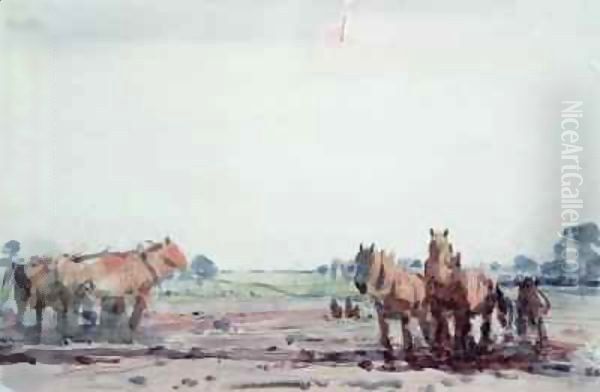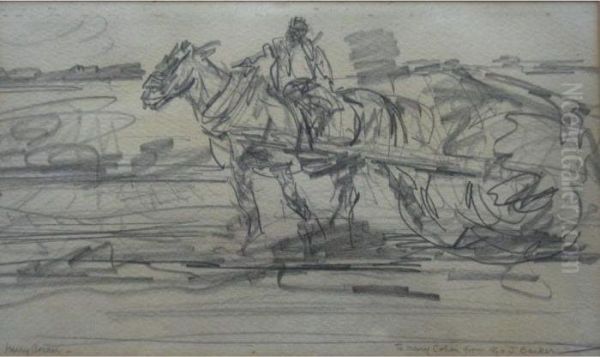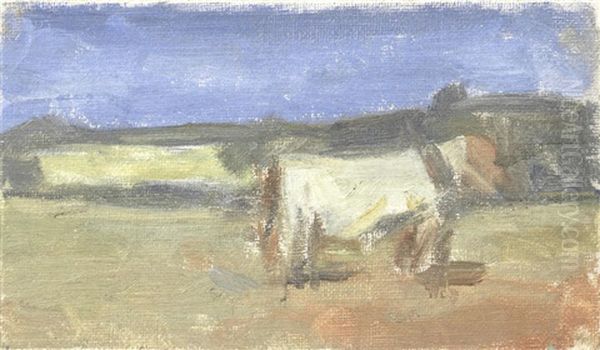Harry Becker (1865-1928) stands as a significant, if sometimes overlooked, figure in British art, an artist whose dedication to depicting the agricultural life of East Anglia, particularly Suffolk, provides an invaluable record of a world on the cusp of irreversible change. A painter, draughtsman, and printmaker of considerable skill, Becker’s oeuvre is characterized by its robust honesty, its empathetic portrayal of human and animal labour, and its deep connection to the soil. His work, rooted in the traditions of 19th-century European Realism and Naturalism, and touched by the atmospheric concerns of Impressionism, offers a profound insight into the rhythms and realities of rural existence.
Early Life and Artistic Foundations
Born in Colchester, Essex, in 1865, Harry Becker was the son of a German immigrant doctor, a background that perhaps instilled in him a keen observational capacity. His artistic inclinations were evident from an early age, leading him to pursue formal training that would shape his distinct visual language. His foundational studies took place at the prestigious Royal Academy of Fine Arts in Antwerp, a city with a rich artistic heritage, known for its rigorous academic training which would have grounded him in the fundamentals of drawing and composition.
Following his time in Antwerp, Becker sought to broaden his artistic horizons in Paris, the undisputed epicentre of the art world in the late 19th century. There, he enrolled in the atelier of Charles-Auguste-Émile Durand, famously known as Carolus-Duran. This was a significant choice, as Carolus-Duran was a highly respected portraitist and teacher whose own work balanced academic skill with a modern sensibility. His studio attracted numerous aspiring artists, including the celebrated American painter John Singer Sargent, who became one of Carolus-Duran's most famous pupils. The emphasis in Carolus-Duran's teaching was on direct painting, accurate tonal values, and capturing the essential character of the subject, principles that would resonate throughout Becker's career.
The Parisian Influence: Impressionism and Naturalism

Becker's time in Paris, from 1886 to 1890, exposed him to the revolutionary currents of Impressionism and Post-Impressionism, as well as the enduring strength of the Realist and Naturalist movements. While he may not have fully embraced the broken brushwork or high-keyed palette of artists like Claude Monet or Camille Pissarro in their purest forms, the Impressionist emphasis on capturing fleeting moments, the effects of light and atmosphere, and scenes of contemporary life undoubtedly left a mark.
More profoundly, Becker seems to have absorbed the spirit of French Naturalism, a movement that sought to depict ordinary people and their environments with unvarnished truthfulness. The works of Jean-François Millet, with his dignified portrayals of peasant life, such as The Gleaners or The Sower, provided a powerful precedent for artists wishing to explore rural themes. Similarly, Gustave Courbet’s robust Realism and his commitment to painting the tangible reality of his surroundings offered an alternative to academic idealism. Becker’s later focus on the labourers of Suffolk echoes the thematic concerns of these French masters, albeit translated into a distinctly English context. The influence of Edgar Degas, particularly his innovative compositions, his use of mixed media, and his ability to capture figures in motion with a sense of immediacy, is also discernible in Becker's dynamic drawings and prints.
A Sojourn in London and the Call of the Countryside
After completing his studies in Paris, Becker returned to England and spent some time in London, establishing a studio and seeking to make his mark on the capital's art scene. He achieved a measure of success, exhibiting at the Royal Academy and other venues. He also undertook commercial work, including a notable, though ultimately unrealised, commission to create large-scale murals for Gordon Selfridge's new department store on Oxford Street. This period saw him engage with the London art world, where figures like Walter Sickert, with his Camden Town Group's focus on urban realism, and Philip Wilson Steer, who was exploring Impressionist-influenced landscapes, were prominent.
However, Becker grew increasingly disillusioned with the commercialism and social intricacies of the London art establishment. The city, for all its artistic ferment, did not seem to provide the authentic subject matter that truly resonated with his artistic temperament. His heart lay elsewhere, in the agricultural landscapes and the working communities he had known from his youth in Essex and would soon discover with profound intensity in Suffolk. This dissatisfaction prompted a pivotal decision to leave the metropolis and immerse himself in the rural life that would become the central focus of his art.
Immersion in Suffolk: A Life Dedicated to the Land

Around 1913, Harry Becker made the decisive move to Suffolk, initially settling in the Wenhaston and Blythburgh area, near Southwold. He later moved to a small cottage in Darsham and then to Old Hall Farm in Halesworth, where he lived and worked in relatively impoverished conditions, often exchanging his art for goods and services. This deliberate choice to live among his subjects, sharing their environment and observing their daily toil at close quarters, was fundamental to the authenticity and power of his work. He became a familiar figure in the fields, sketching and painting with a directness and vigour that captured the essence of agricultural life before the widespread mechanisation that would transform it in the decades following his death.
His subjects were the farm labourers themselves: men ploughing with heavy horses, scything hay, hedging, ditching, tending to livestock, and women engaged in tasks like gleaning or potato picking. He depicted the animals – the Suffolk Punch horses, cattle, pigs, and sheep – not as sentimentalised creatures, but as integral parts of the working farm, their power and weariness palpable. The Suffolk landscape, with its wide skies, rolling fields, and distinctive farm buildings, formed the ever-present backdrop to these scenes of human and animal endeavour. Becker’s commitment was to truth, to portraying the unromanticised reality of hard physical work, the dignity of labour, and the deep, often challenging, relationship between people and the land.
Mastery Across Media: Painting, Drawing, and Printmaking
Harry Becker was a versatile artist, proficient in several media, each suited to different aspects of his observational practice. His oil paintings, often executed with a vigorous, direct application of paint, convey the weight and texture of the Suffolk landscape and the figures within it. Works like A Man Hedging (1928) demonstrate his ability to capture the physicality of labour and the muted colours of the rural scene. He often worked on a large scale, reflecting the expansive nature of his subjects.
His drawings, frequently in charcoal, crayon, or conte, are particularly noteworthy for their dynamism and economy of line. Sketches such as Man with Buckets in The Barn (1928) or Man Milking (1928) reveal his acute eye for gesture and movement, capturing the essential forms and energy of his subjects with remarkable speed and confidence. These drawings were not merely preparatory studies but often finished works in their own right, valued for their immediacy and expressive power. He would often sketch directly in the fields, sometimes on scraps of paper or any available surface, driven by the urgency to record what he saw.

Becker was also a highly accomplished printmaker, particularly renowned for his etchings and lithographs. Printmaking allowed him to explore tonal contrasts and linear qualities in a different way, and to produce multiple images that could reach a wider audience. His etchings, such as Milking, often possess a gritty realism and a strong sense of atmosphere. His lithographs, like Working in the fields, in a glazed frame, showcase his skill in capturing the broad forms and light of the agricultural landscape. These prints stand alongside the work of other notable British printmakers of the era, such as James McNeill Whistler, whose revival of etching had a significant impact, and later figures like Muirhead Bone or Griggs, who also explored architectural and landscape themes.
Themes and Artistic Style: A Unique Vision
The overarching theme of Harry Becker's work is the depiction of agricultural labour in East Anglia. He was, in essence, a "peasant painter" in the tradition of Millet, but with a distinctly English sensibility. His style can be described as a form of expressive Realism or Naturalism. While he learned from Impressionism, particularly in his attention to light and atmosphere, his primary concern was with the solidity of form and the truthful representation of his subjects. There is little sentimentality in his work; instead, there is a profound respect for the resilience and endurance of the people he portrayed.
His compositions are often direct and uncluttered, focusing on the figures and their actions. He had a remarkable ability to convey the physical strain and rhythmic movements of farm work. His palette, while capable of capturing the subtle hues of the Suffolk countryside, often tended towards earthy tones, reflecting the close connection between the labourers and the soil. His figures are not idealized; they are depicted with a rugged honesty that acknowledges the hardships of their lives but also celebrates their strength and dignity. This approach set him apart from more pastoral or romanticised depictions of rural life that were common in some quarters of British art. His work aligns more closely with the social realist concerns of artists like George Clausen or Henry Herbert La Thangue, who also depicted agricultural labourers with a degree of unvarnished truth, though Becker's style often possessed a rawer energy.
Recognition and Exhibitions: A Modest but Enduring Presence
During his lifetime, Harry Becker achieved a degree of recognition, though perhaps not commensurate with his talent or dedication. He exhibited at the Royal Academy in London, the Royal Scottish Academy, the Glasgow Institute, and importantly, at the 1906 Milan International Exhibition, where he was awarded a bronze medal for a painting. His work was also shown in various provincial galleries. His etchings found their way into significant public collections, including the Victoria and Albert Museum in London and the Uffizi Gallery in Florence, a testament to their quality and appeal.
Despite these successes, Becker remained largely outside the mainstream art world, particularly after his move to Suffolk. He was not a self-promoter and seemed content to focus on his work, driven by an inner necessity rather than a desire for fame or fortune. This relative obscurity during his later years meant that his contribution to British art was, for a time, somewhat undervalued. However, in the decades since his death in 1928, there has been a growing appreciation for his work. His daughter, Janet Becker, became a historian and played a role in preserving his legacy.
Posthumous exhibitions have helped to bring his art to a wider audience. Notably, the "Inspired by Becker" initiative and annual exhibitions held at Blythburgh Church since 2019, often titled "Cathedral of the Marshes," have showcased his work alongside contemporary artists inspired by him, significantly raising his profile. These events highlight the enduring relevance of his art and his profound connection to the Suffolk landscape and its people. His works are now held in numerous public collections, including the Ipswich Museum and Art Gallery, which has a significant holding.
Contemporaries and Context: Becker in the British Art Landscape
To fully appreciate Harry Becker's contribution, it is useful to consider him within the broader context of British art at the turn of the 20th century. This was a period of diverse artistic activity, with various movements and styles coexisting. The legacy of Victorian academicism was still strong, but new influences were making themselves felt. The Newlyn School in Cornwall, with artists like Stanhope Forbes and Walter Langley, shared Becker's interest in depicting the lives of working people, albeit in a coastal setting and often with a greater emphasis on narrative and sentiment.
In Scotland, the Glasgow Boys, including James Guthrie and E.A. Walton, were also exploring rural themes with a new naturalism and attention to light, influenced by French plein-air painting. Becker's direct, unsentimental approach to agricultural labour finds parallels in their work, though his style remained distinctly his own. While artists like John Singer Sargent, his contemporary from Carolus-Duran's studio, achieved international fame with dazzling society portraits, Becker chose a different path, dedicating himself to the unglamorous but vital world of rural toil. His commitment to this subject matter, pursued with such intensity and integrity, marks him out as a unique voice. He was less concerned with the avant-garde experiments of Post-Impressionism or early modernism that were beginning to emerge with artists like Roger Fry or Wyndham Lewis, and more focused on capturing the enduring realities of the life he observed around him.
The Later Years and Lasting Legacy
Harry Becker continued to work tirelessly in Suffolk until his death in 1928 at the age of 63. He remained committed to his chosen subject matter, even as his health may have declined. There are accounts of him using old canvases and scraps of paper, indicative of his often-straitened circumstances but also his relentless drive to create. He left behind a substantial body of work – paintings, drawings, and prints – that forms a powerful and cohesive artistic statement.
His legacy is multifaceted. Firstly, he is a vital chronicler of a specific time and place: East Anglian agricultural life in the early 20th century, an era before the profound changes brought about by mechanisation and industrialised farming. His work serves as a historical document as much as an artistic achievement, preserving a way of life that has largely vanished. Secondly, his art stands as a testament to the dignity of labour and the profound connection between humanity and the natural world. His empathetic yet unsentimental portrayal of farm workers offers a powerful counterpoint to more romanticised or idealised visions of rural life.
Thirdly, his skill as a draughtsman and printmaker ensures his place among notable British artists of his generation. His ability to capture movement, energy, and character with such economy and power is remarkable. The renewed interest in his work in recent years, fueled by exhibitions and publications, suggests that his art continues to resonate with contemporary audiences, who perhaps find in his honest and direct vision a refreshing authenticity. He taught and influenced other artists, including some Finnish painters, acting as a conduit for European artistic trends. Harry Becker’s unwavering focus on the Suffolk soil and its people has ensured that his art, born from a deep empathy and a keen observational eye, remains a significant and moving contribution to the story of British art.